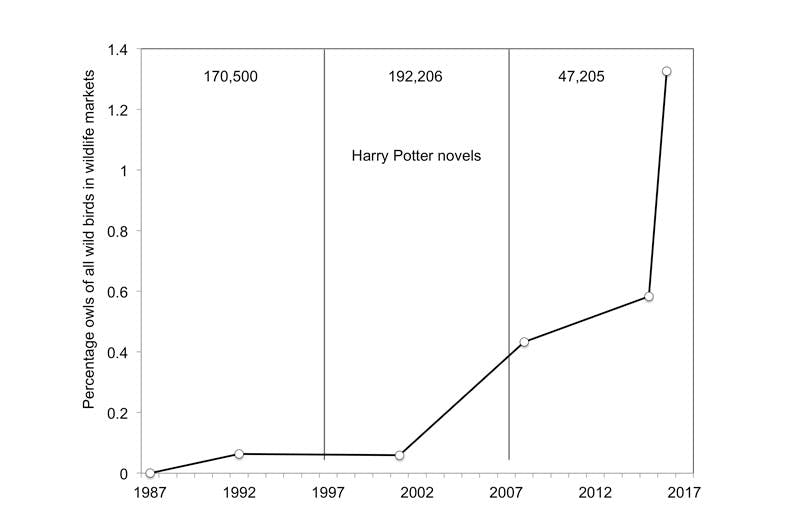The Harry Potter books and movies seem to have fueled a dramatic rise in the number of owls being traded as pets in Indonesia, a new study concludes.
In the past, conservationists have suggested that the popularity of the fictional mail-delivering owls in the Harry Potter books may have caused an uptick in the illegal trade in owls in countries like India. Now, scientists believe that the “Harry Potter effect” may have done the same in Indonesia.
Birds have always been popular pets in Indonesia. But owls were rarely recorded in the country’s bird markets in the 1980s, 1990s and early 2000s, Vincent Nijman and Anna Nekaris of Oxford Brookes University report in the study published in Global Ecology and Conservation. This trend appears to have changed in the late 2000s.
“
It is particularly heart breaking to see nocturnal animals like owls in the markets. Looking stunned and stressed under the bright sun, they are often only fed water and rice, making the situation all the more pitiful.
Anna Nekaris, report author, Oxford Brookes University
Surveys of 20 bird markets in Java and Bali conducted between 2012 and 2016 revealed that owls are now widely traded.
At least 12,000 Scops owls (Otus spp.) are being sold in Indonesia’s bird markets each year, the researchers estimated, in addition to a thousand other larger owls like the Australasian barn owl (Tyto javanica), the Oriental bay owl (Phodilus badius) and the Buffy fish owl (Bubo ketupu). In the Harry Potter films, Ron Weasley’s pet owl, nicknamed Pigwidgeon, is depicted as a common scops owl (Otus scops).

Figure shows the percentage of owls as the total number of wild birds in the bird markets in Indonesia between 1987 and 2016. The Harry Potter books were published between 1997 and 2007. Sample sizes at the top are the total number of wild birds recorded in the markets in these three periods. Figure by Nijman and Nekaris 2017.
Most of these owls are caught from the wild, the study says, which makes the trade largely illegal.
“In the 1990s, when surveying the bird markets I would typically see one or two owls for sale amongst the thousands of wild-caught birds on offer but equally often not a single owl was on display,” Nijman said in a statement. “Now, returning to those same markets we can see dozens of owls for sale of a wide range of species and owls are always present, all taken from the wild.”
While it is difficult to prove that the Harry Potter series has definitively caused the rise in owl trade in Indonesia, the researchers are convinced that there is a link between the two.
The Harry Potter books and movies were translated and released in Indonesia in the early 2000s. Around the same time, internet access began to increase in the country, followed by a rise in social media use, the researchers say.
“The increase in the number of owls offered for sale since 2010 not only in Jakarta but throughout Java and Bali, coincided with an increase in the number and level of organisation of the pet owl communities, online and offline, and this, as much as the Harry Potter films and novels, might explain the popularity of owls as pets in Indonesia,” the authors write in the study.
The study adds that the owl trade in Indonesia is not only illegal but also poorly regulated and possibly unsustainable.
“It is particularly heart breaking to see nocturnal animals like owls in the markets,” Nekaris said in the statement. “Looking stunned and stressed under the bright sun, they are often only fed water and rice, making the situation all the more pitiful.”
“About half of the 2,000 or so owls we encountered in the markets were downy chicks, taken from their nests, and we expect the majority of them to die within weeks; this does not appear to be a sustainable trade,” she added.










